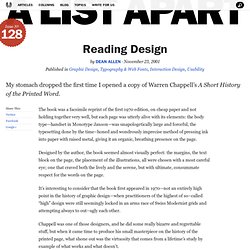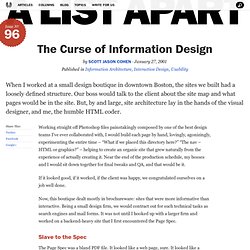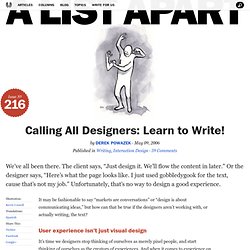

Job Candidates. Technology. Media Services. School. Jobs. Welcome to Shelfari! Read, Share, Explore! Reading Design. My stomach dropped the first time I opened a copy of Warren Chappell’s A Short History of the Printed Word.

The book was a facsimile reprint of the first 1970 edition, on cheap paper and not holding together very well, but each page was utterly alive with its elements: the body type—handset in Monotype Janson—was unapologetically large and forceful, the typesetting done by the time–honed and wondrously imprecise method of pressing ink into paper with raised metal, giving it an organic, breathing presence on the page. Designed by the author, the book seemed almost visually perfect: the margins, the text block on the page, the placement of the illustrations, all were chosen with a most careful eye; one that craved both the lively and the serene, but with ultimate, consummate respect for the words on the page.
It may be that, for Chappell, it was easier to perform like a virtuoso when designing his own words, at his own pace. How can you design for the web if you can’t code?
Services. Client Sites. Webdesign. Web Development. Home. Programming. OS. Personal Projects. Photography. Wedding. Most Important - Jesus. UsabilityPost. What are you working on? Beyond Usability and Design: The Narrative Web. The web is currently torn by two strong forces, seemingly irresistible and irreconcilable.

On the one hand, usability and interface engineering argue for simplicity, consistency, and clarity – for a starkly functional minimalism. On the other, emerging web standards and technologies nourish a continuing efflorescence of new approaches to web design. On the one hand, rigid hierarchical structure, branded as Information Architecture, promises clarity and coherence; on the other, the same rigidity seems to offer sterility and boredom. First one side darts ahead. The lead seems insurmountable.
But this tumultuous race, with cheerleaders on either side, ignores a third force: the power of narrative. eNarrative everywhere#section1 We see narrative everywhere. We want to see narrative everywhere. The point is not that we should add stories to our sites to ensnare narrative-starved readers. Arcs of triumph#section2 Organic narrative#section3 The world abounds in stories. The Curse of Information Design. When I worked at a small design boutique in downtown Boston, the sites we built had a loosely defined structure.

Our boss would talk to the client about the site map and what pages would be in the site. But, by and large, site architecture lay in the hands of the visual designer, and me, the humble HTML coder. Working straight off Photoshop files painstakingly composed by one of the best design teams I’ve ever collaborated with, I would build each page by hand, lovingly, agonizingly, experimenting the entire time – “What if we placed this directory here?”
“The nav – HTML or graphics?” – helping to create an organic site that grew naturally from the experience of actually creating it. If it looked good, if it worked, if the client was happy, we congratulated ourselves on a job well done. Now, this boutique dealt mostly in brochureware: sites that were more informative than interactive. Calling All Designers: Learn to Write! We’ve all been there.

The client says, “Just design it. We’ll flow the content in later.” Or the designer says, “Here’s what the page looks like. I just used gobbledygook for the text, cause that’s not my job.” Unfortunately, that’s no way to design a good experience. It may be fashionable to say “markets are conversations” or “design is about communicating ideas,” but how can that be true if the designers aren’t working with, or actually writing, the text? User experience isn’t just visual design#section1 It’s time we designers stop thinking of ourselves as merely pixel people, and start thinking of ourselves as the creators of experiences. Let’s look at everybody’s favorite example of Doing it Right: Flickr. Why? I say: It’s the writing. Text is interface#section2.